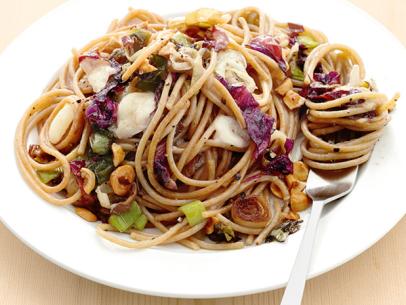Spaghetti, a type of long, thin, solid pasta, is a popular food in traditional Italian cuisine. Just like other pasta, it is made using water and milled wheat. Durum wheat semolina is used to make Italian spaghetti. Since it is carb-heavy, rich, and easy-to-prepare, it is among the most popular comfort foods around the world. But the question remains, is it good for you? Should you include it in your diet? Let's find out now!

Is Spaghetti Good for You?
Yes, it is. In fact, you can enjoy several health benefits by eating the right type of pasta. Spaghetti is good for your health mainly because it is a grain food, and whole grains are appreciated for their fiber content and nutritional benefit. The addition of whole grains in your diet lowers your risk of diabetes, heart disease, and cancer. Here are some other reasons why spaghetti is actually healthy.
1. Energy Boost
Since it is made using water and flour, it is a good source of carbohydrates. Carbs are the main source of energy for your body. Studies show that you should be getting 45-65% of your daily caloric intake from carbs. Some fad diets revolve exclusively around fat and protein, but you should also include some form of carbs in your diet to stay healthy. Spaghetti can certainly get you a carb fix.
2. Packed with Nutrients
Is spaghetti good for you? The answer is in yes, and the reason is that it is a great source of minerals, vitamins, and fiber, especially if you opt for whole-wheat or whole-grain pasta. You get about 2 g of fiber along with 90 calories from a half cup serving of whole-wheat pasta. It also provides you with iron and calcium. Whole grains are also a good source of potassium, selenium, and magnesium. Potassium is good for your heart, selenium is essential for the proper functioning of thyroid hormones, and magnesium supports healthy muscles, metabolism, bones, and nerves.
By opting for spaghetti sauce, you also get a good amount of iron along with the antioxidant lycopene. Studies show that you can reduce your risk of cancer by including tomato-sauce pasta dishes in your diet. That is mainly due to the presence of lycopene that prevents oxidative damage.
3. Cardiovascular Benefits
You can include spaghetti in your diet to enjoy cardiovascular benefits. These benefits come from the fact that pasta does not contain any cholesterol and is very low in sodium. You can lower your risk of developing heart problems by replacing high-sodium and high-cholesterol foods with whole-wheat pasta.
Tips for Choose the Healthiest Spaghetti
Is spaghetti good for you? Yes if you know how to select the right type of spaghetti. Here is a simple guide to help you make the best choice.
1. Whole Wheat
 You can always enjoy several health benefits when opting for whole-wheat spaghetti. It provides you with plenty of fiber-rich bran, germ, and other important nutrients. Be sure to opt for this type if you have no problem eating wheat.
You can always enjoy several health benefits when opting for whole-wheat spaghetti. It provides you with plenty of fiber-rich bran, germ, and other important nutrients. Be sure to opt for this type if you have no problem eating wheat.
2. High Fiber
 Made using refined durum wheat, high-fiber spaghetti is a good choice if you want to increase your fiber intake. It may taste a bit like white pasta but it is a healthier choice. Be sure to check the label before making a purchase and ensure that it provides you with at least 20% of your recommended daily intake of fiber.
Made using refined durum wheat, high-fiber spaghetti is a good choice if you want to increase your fiber intake. It may taste a bit like white pasta but it is a healthier choice. Be sure to check the label before making a purchase and ensure that it provides you with at least 20% of your recommended daily intake of fiber.
3. Multigrain
 Made using different types of grains, multigrain spaghetti provides you with impressive health benefits. It usually includes wheat along with ground grains like barley and some flours made from lentils. You can find multigrain spaghetti made with gluten-free grains, like quinoa, rice, or amaranth. Be sure to check the label though and ensure there is the word "whole" before all flours.
Made using different types of grains, multigrain spaghetti provides you with impressive health benefits. It usually includes wheat along with ground grains like barley and some flours made from lentils. You can find multigrain spaghetti made with gluten-free grains, like quinoa, rice, or amaranth. Be sure to check the label though and ensure there is the word "whole" before all flours.
4. Rice
 Usually made from white rice flour or brown rice flour, this type of spaghetti is a suitable choice for anyone with a rather sensitive stomach. Avoid cooking it too long though because it absorbs water quickly than other gluten-free pastas and can turn to mush.
Usually made from white rice flour or brown rice flour, this type of spaghetti is a suitable choice for anyone with a rather sensitive stomach. Avoid cooking it too long though because it absorbs water quickly than other gluten-free pastas and can turn to mush.
5. Quinoa
 Due to its stronger taste, quinoa spaghetti usually includes another milder grain, such as corn. Try this if you are looking for some gluten-free spaghetti options. It packs a serious protein punch and is something sturdier as compared to other gluten-free pastas, which is another reason why you can easily include it in gluten-free pasta salads.
Due to its stronger taste, quinoa spaghetti usually includes another milder grain, such as corn. Try this if you are looking for some gluten-free spaghetti options. It packs a serious protein punch and is something sturdier as compared to other gluten-free pastas, which is another reason why you can easily include it in gluten-free pasta salads.
Tips for Weight Loss
Is spaghetti good for you? Yes, it certainly is, and you can double those benefits by selecting the best type of spaghetti for you. There is something about spaghetti that you may not already know – it can have a place in your weight loss diet. Here are a few impressive tips to consider.
- Enjoy spaghetti with a weight loss-friendly sauce. You can find many options, like cheese sauce, but that would not be a great choice considering a half-cup of cheese sauce provides you with 240 calories and 10g of unhealthy saturated fat. Tomato sauce is a better option because a half-cup serving only provides you with 30 calories.
- Consider serving spaghetti with lots of veggies. You can extend your portion size in this way without having to worry about increasing the number of calories. When making whole-wheat spaghetti, mix it with spiralized zucchini to make a bigger portion size. You can also mix it with sautéed veggies into your sauce. Add some chopped green peppers, mushrooms, and onions to your spaghetti to make it healthier.
